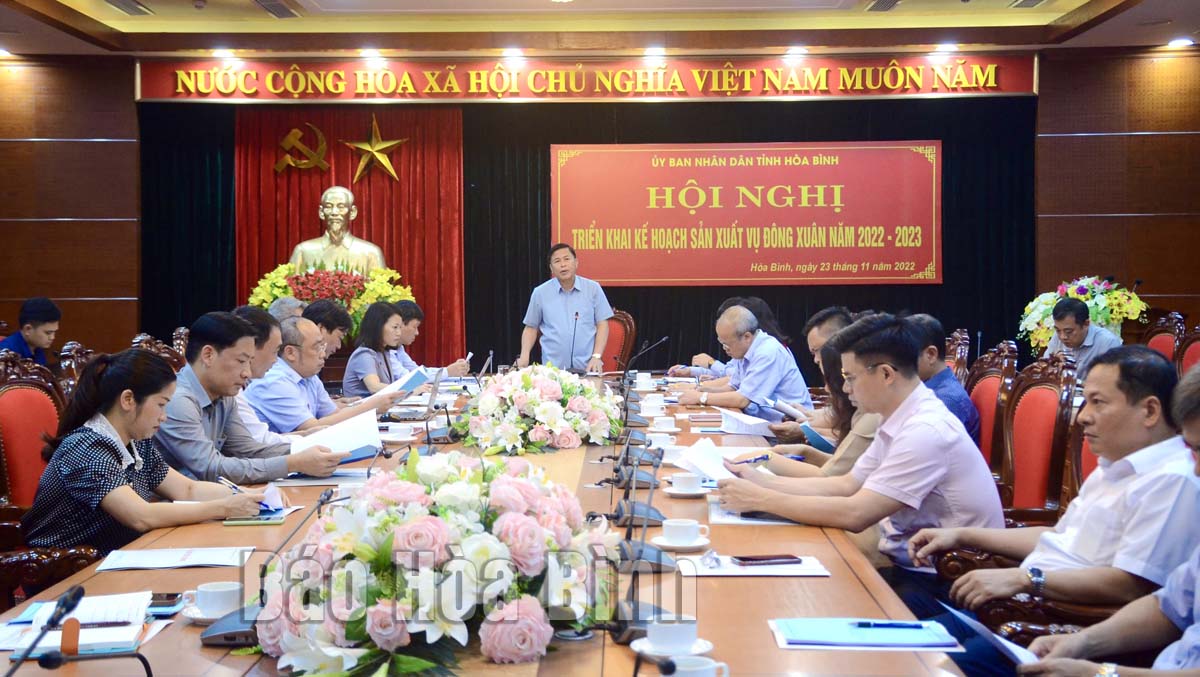
(HBO) - The People's Committee of Hoa Binh province held an online conference on November 23 with districts and Hoa Binh city to roll out the production plan for the 2022-2023 winter-spring crop, under the chair of Vice Chairman of the provincial People's Committee Dinh Cong Su.
Vice Chairman
of the provincial People's Committee Dinh Cong Su speaks at the online conference.
In this year's summer-autumn crop, the total cultivation
area reached 45,730 hectares, equal to 100.2% of the same period last year and
105.2% of the plan. The area of grain crops was 33,510 hectares, equivalent to
100.6% of the same period last year and 102.8% of the plan. The output of grain
crops is estimated at 36,500 tonnes this year, up 1.7% year-on-year, and 1.49%
compared to the plan.
The province has planted about 7,900 hectares of forest,
equal to 138% of the plan; and the forest coverage is maintained at 51.5% of
the province's area. Regarding aquaculture, there are 4,850 fish cages in the
province, and the water surface area for aquaculture is 2,700 hectares. This
year’s aquatic product output is estimated at 12,170 tonnes, 1.000 tonnes
higher than that of the same period last year.
At the conference, participants discussed and analysed the
achieved results, and clarified shortcomings and limitations in summer-autumn
crop production. For the winter-spring crop, they agreed to strive for a
cultivation area of 117,000 hectares, increasing the sugarcane growing area to
7,300 hectares; and citrus for harvest over 7,500 hectares.
Appreciating the results achieved in the production of the
summer-autumn crop, Vice Chairman Su emphasised that the winter-spring crop has
a large planting area, with many types of intensive cultivation plants with
high productivity, which can determine the production results of the whole
year.
However, crop diseases can be complicated, and prices of
agricultural inputs remain high, he stressed, asking localities to focus on
carrying out specific groups of solutions to achieve comprehensive results, and
increase the application of scientific and technological advances to production
to increase productivity and quality and value of agricultural products.
In addition, localities should pay more attention to
production and value chains, and develop OCOP (one commune-one product)
products of the province./.
Hoa Binh province is undergoing a dynamic transformation amid Vietnam’s national digital transition. Building on Poliburo’s Resolution No. 57-NQ/TW on breakthroughs in science, technology, innovation, and national digital transformation, the province has rolled out a wide range of practical action plans. A standout initiative is the "Digital Literacy for All” movement, an effort to ensure that no one is left behind in the digital era.
Hoa Binh province is undergoing a dynamic transformation in the wake of the national digital transformation movement. Building on Resolution No. 57-NQ/TW of the Politburo on breakthroughs in science, technology, innovation, and national digital transformation, the province has implemented a wide range of practical action plans. A standout initiative is the "Digital Literacy for All” movement ambitious effort to ensure that no one is left behind in the digital age.
With a spirit of unity and proactive problem-solving, the Party Committee, the government and the people of Dong Lai Commune (Tan Lac District) have made great strides in implementing the resolutions of the 24th Party Congress of the commune for the 2020 - 2025 term. Focusing on leadership and practical actions, the commune has brought the Party’s resolutions into daily life, creating strong impacts and pushing the local development forward.
Amid the nationwide push for digital transformation, young people in Hoa Binh Province are stepping up as dynamic pioneers, applying technology to enhance Youth Union operations and expand the reach of youth-led initiatives. Through creativity and adaptability, Youth Union organizations at all levels have introduced a series of practical solutions, contributing to modern governance and community development.
In recent years, An Nghia commune, located in Lac Son district, has stepped up administrative reform, focusing on improving the quality and efficiency of its single-window service unit for receiving and processing administrative procedures. These improvements have helped create favourable conditions for local residents and organisations to handle administrative procedures, contributing to the commune’s broader socio-economic development.
The Prime Minister-approved master plan to develop the multi-use value of forests ecosystems through 2030, with a vision to 2050, aims to improve the management and sustainable use of forest resources, create jobs, increase incomes, and improve the living standards of ethnic minorities, people in mountainous and remote areas, forest workers and those living near forests.



